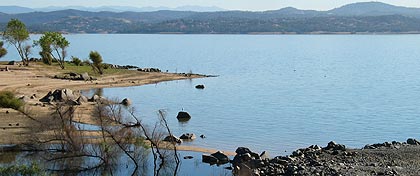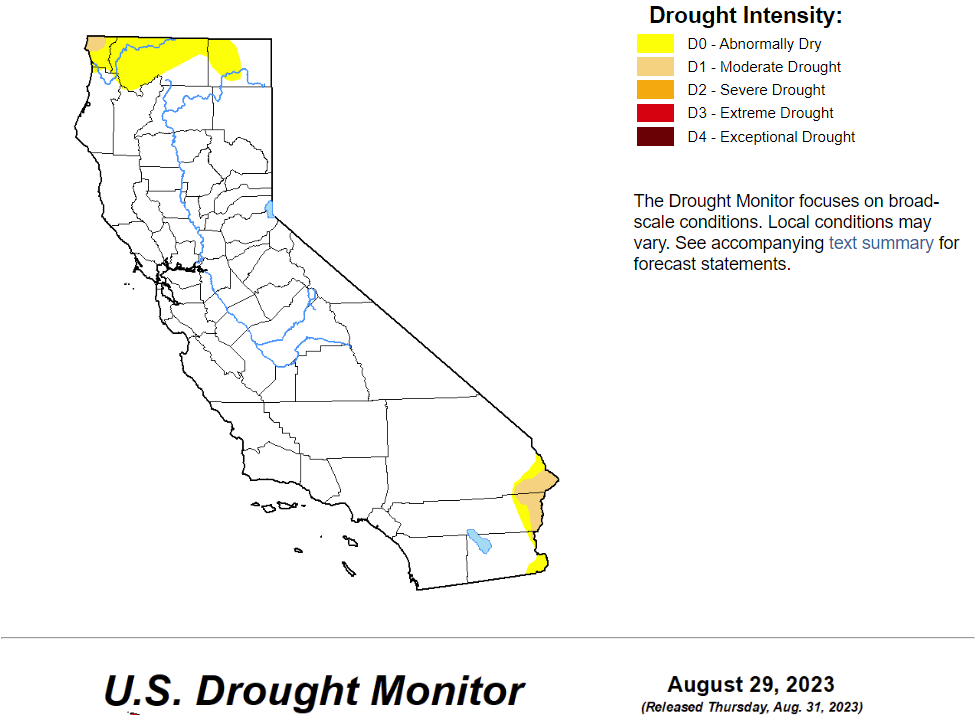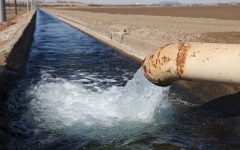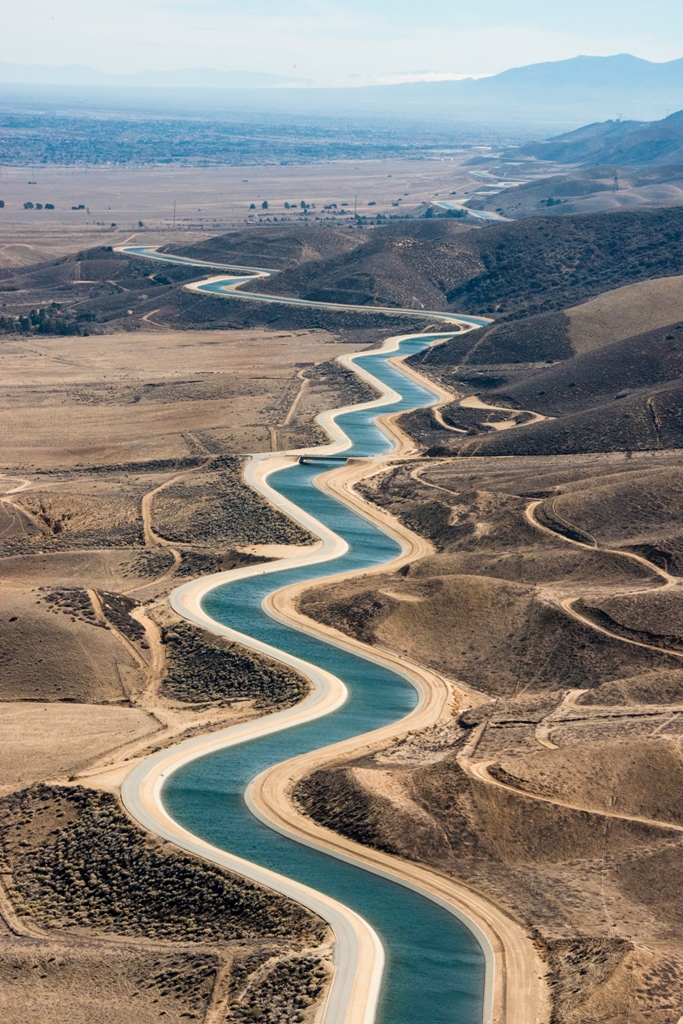
Folsom Lake. (Photo: parks.ca.gov)
California Regional Water Usage Declines As Statewide Water Stores Remain Above Average
Drought conditions virtually erased statewide
By Evan Symon, September 6, 2023 2:30 am
According to new data released by the California State Water Resources Control Board (SWRCB), average monthly residential water use sharply declined in the first half of 2023, with water stores in reservoirs and other places continuing to remain well above average.
Since the late 2010’s until earlier this year, California was under a megadrought, with 100% of the state being at least under a ‘moderate drought’ in October 2022. In some reservoirs, water stores became so low that electric generators stopped working, while others, like Lake Oroville, had water levels become so low that giant ‘bathtub rings’ of where the water level was once at became prominent features.
As a result, water restrictions were placed statewide, with some areas, such as Los Angeles, even severely limiting law watering to only a few days a week and banning self-washing of cars. Both state and local water districts went after water usage with a vengeance, with some officials even starting to mention trucking in water because of the dire situation. Many in late 2022 predicted that 2023 was just going to be another drought year, with many districts going so far as to introduce new water residential use caps for the next year in preparation.
However, instead of another drought year, 2023 became the year of rain and flooding. Several atmospheric river event struck the state in January and March, bringing down record rain amounts, flooding, and in the mountains, near record snowpack levels. Because of the rain and subsequent meltwater, reservoirs have remained at or near full brim. Lake Oroville, for example, went from a 710 foot level in June 2021 to a 900 foot full brim in June 2023. Thanks to other rain events, Lake Oroville is still above the 850 foot mark in September for the first time in years.
Out on the mountains, ski season ended only last month at some Tahoe resorts because of the earlier snowfall. Drought conditions were also erased, with only half the state remaining under drought conditions in March, and virtually none of the state being in drought anymore as of September 1st. Further helping matters was Hurricane Hilary. While the storm did bring flooding to areas such as Palm Springs, the August storm brought new rainfall in a month where Southern California usually doesn’t get any, recharging groundwater and reservoirs in the matter of a few days.

Water in California
Along with the rain came drought measures. Statewide water restrictions were ended in March, with areas that suffered more under the drought, like Los Angeles, lifting some drought measures in July. Water shortage emergency orders have also been removed from most counties. But, many water districts have reported that, even with restrictions lifted, many residents have kept up water conservation despite a greater water supply. The rains that have come throughout the year have also caused many to not self water or otherwise use water for things that natural rainwater would take care of.
All this led to the new State Water Resources Control Board data this week, showing a drastic decline in water usage statewide. In terms of average monthly residential gallons per capita daily (GPCD), the Central Coast went from 78 GPCD in 2020 to 81 GPCD in 2021 to only 69 GPCD this year. San Francisco saw a similar drop, going from 78 GPCD in 2020 to only 62 GPCD this year. Los Angeles County was another notable decline, going from a high of 85 GPCD in 2021 to 78 GPCD in 2022 to only 69 GPCD in the first half of 2023. Agricultural areas saw declines as well, with Kern County going from 153 GPCD to 129 GPCD in the same time period.
Water experts told the Globe on Tuesday that with the rest of the year expected to be more on the milder side, California is expected to be in good shape for the rest of the year.
“Keep in mind that the numbers aren’t telling the full story,” said Jack Wesley, a water systems consultant for farms and multi-family homes. “Water usage is way down in large part because people didn’t have to put on the sprinklers for much of the year. Same with farms needing water. All the meltwater coming down solved any irrigation problems most farmers had had. Conservation measures did help some, but it was more due to the fact that it rained so much and people didn’t need to use outdoor water nearly as much.”
“That being said, we will get some higher temperatures in the next several weeks like we always do, but otherwise, California looks like they are back on track water-wise. It took a bunch of storms, record rain and snowfall, and late year storms, but it happened. 2024 is still a mystery. Experts said that droughts were becoming more likely, but now some are saying that these big rain bombs could be the norm too. The state is getting ready either way. Water restrictions have now been tried and they know what they can implement in the future now in case it is needed again, and we are also now building more and more flood and flood control measures in case of big storms again. New water storage capabilities are being addressed, but so are ways to safely relieve flooded areas.”
“What we still need to work on is longer term droughts and wet periods. California was not prepared for the mega drought, nor were they fully prepared for the months of rain earlier this year. That’s for sure. But, these statistics show that we don’t have to worry about water for awhile, which , for this state, I think we have some good news.”
Full 2023 statistics on water usage are to come out early next year.
- Bill to Require Law Enforcement Disclosure if AI Was Used To Help Write Reports - August 7, 2025
- Gov. Newsom Files FOIA Request To ‘Expose True Cost’ Of L.A. Federal Troop Deployment for Anti-ICE Riots - August 6, 2025
- California Redistricting: How Newsom’s Plan Will Demolish Hard Fought GOP Gains - August 6, 2025





Evan Symon & Katy Grimes both need to look more into the Amazing Kristi Diener’s, CA Water For Food and People Movement, on Face Book~!~! Kristi Diener & her ever-so-polite admins have detailed how “Gavin’s” CA State Government Administration has Purposefully Destroyed over one million acres of CA multi-generational farms, ranches, orchards & vineyards, (just Not “Gavin’s” three vineyards)~!~!
It would be nice to have The California Globe actually print stories more deeply upon the Big Truths of “Gavin’s” criminally using Our Water to Harm All of California citizens~!
Like the Big, True fact that the Cal-Gov has Not Built Any New Water Reservoirs during the last Forty Years~! Even though The People voted in a new reservoir 40 years ago~!~!
“Gavin” has used his California Water Resource Control Board Sacramento bureaucrats to create their orchestrated destructions of our CA water use, this by means of Utterly Wastefully flushing trillions of gallons of OUR Water out to sea, rather than to appropriately give our remarkable food-creators the water which they have & had Already Paid For~!~!
Thx.
Just wait until Hairgel Hitler Newsom has his water board minions open the drain gates on the reservoirs to let the water run out to the sea, so they can declare another “water emergency” associated with “climate change”, which is the “existential threat of our lifetimes” according to these lying cheating SOB’s….
Rather than operating in a fiduciary capacity for the citizens of California, Newsom appears to be running interference for the WEF and Agenda 2030, as a good “Young Global Leader” should do…
Still waiting for the additional reservoirs that were voted in DECADES ago to be built… what’s the holdup, Sacramento???